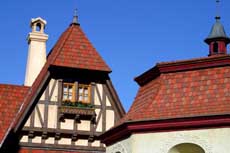

Covering of any building by which its fabric and habitants are protected from the inclemencies of the weather. Roofs are here considered as to their form or type and finish, the structure of roofs being dealt with elsewhere. Cladding of roofs may be of metal, glass, slate, stone, thatch, tile, turf, wood, or other materials. Greek temples had marble roofs, the slabs worked to prevent leaks the Romans used tiles medieval churches were clad in lead, tiles, or thatched and since a variety of materials has been used. Barry's Palace of Westminster, for example, is clad in cast-iron panels. Types of roof include: appentice: see lean-to barrel: roof with internal appearance of a barrel-vault, like a cylinder catslide: pitched roof covering one side of a roof and continuing at the same pitch over a rear extension, commonly found in Colonial architecture in New England, where it is referred to as a saltbox. A catslide can also be the roof of a dormer pitching in the same direction but less steeply than the main roof compass: see truss cradle: see trusscurb: pitched gable-roof with the slopes broken to form two sets of planes on each side, the outer planes being steeper in pitch. Similar to a mansard roof, but with a curb or horizontal band with a vertical face at the junction between the two pitchescut: see truss double–: see truss French: curb-roof with the sides set at very steep angles and the pitched top part almost flat gable or pitched: commonest type with sloping sides meeting at a ridge and with a gable at each end gambrel: in the USA curb roof with only the two sides sloping, but in Britain a hipped roof with a small gable or gablet under the ridge at one or both ends half-hipped: pitched roof with gables terminating in hipped roofs helm: with four sloping sides joining at the apex, like a pyramid, set on a square tower with gables the tops of which coincide with the lines of the junctions between the sides of the roof. The sloping sides sweep downwards over the raking tops of the gables, and terminate in points where the gables join hipped: with four pitched slopes joining at hips, and without gables. Lean-to: monopitched appentice, set against a higher wall, as over an aisle and against a clerestorey of a basilican church M–shaped: with two parallel pitched roofs meeting in a valley or gutter mansard: named after F. Mansart, a curb-roof with steeply pitched or curved lower slopes and pitched or hipped roof over, almost invariably with dormer-windows. Distinguished from the French roof in having a more steeply pitched upper part, and in the USA called gambrel, pavilion, hipped on all sides to have a pyramidal or almost pyramidal form, as pyramid-roof penthouse: as lean-to, but not necessarily associated with a church, so a simple monopitched roof pitched: as gable pyramid: shaped like a pyramid or a hipped roof with a very short ridge so that the slopes almost meet at a point, as pavilion ridge: any pitched roof with the sloping sides meeting at a ridge saddleback: ordinary gable-roof on top of a tower shed: as penthouse single–framed: see truss slab: flat roof consisting of one slab of concrete or of several concrete slabs joined together and spanning between walls span: ridge roof of two equal slopes as distinct from a lean-to or penthouse-roof suspended: web or webs hung on cable-nets stretched between heavy cables fixed to masts and the ground, as in Otto's work, called a tent-roof tent: with a concave surface like a camp roof, or sloping inwards with a convex surface, such as the roof of a Regency balcony or a verandah terrace: flat roof with imperceptible slope or fall, waterproofed, and permitting free use for sitting, etc. trough: M-roof valley: M-roof, or roof covering a building with projecting wings requiring valleys where the subsidiary roofs join the main roof. Courtesy of: JW Roofing the best Miami Roofer installing great tile, and shingle roofs all over miami and south Florida.
Head back to our Roofing History Project home page.